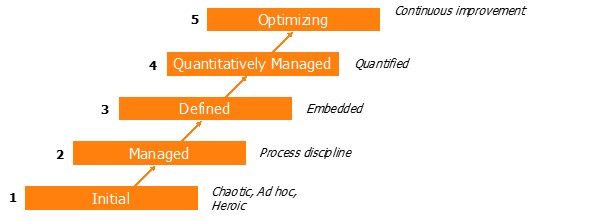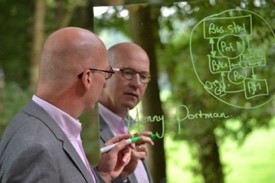Stirring in the fruit bowl
FEATURED PAPER
By Henny Portman
The Netherlands
Why maturity models or excellence models?
The success rate of projects is still very low. If I look at the latest figures from the Standish Group (CHAOS 2020 – Beyond infinity)[1] 60% or more, depending on your approach (agile or waterfall) is not successful. This is already for several decades the case!
To improve the way you are running projects, there are several paths to follow. You could look at the way your organization is doing projects. Or with other words how mature is your organization in doing projects? Some well-known maturity models are CMMI, OPM3, and P3M3. Another approach is to look at individual projects and ask how well this project was performed? Think about all those yearly contests that are running. E.g., the IPMA Global Project Excellence Awards[2], the PMO Global Awards[3], and the PMI Project Awards[4].
When you want to say something about maturity you have to look at the standards an organization has set and how they apply those standards to their projects. If one project is using the standards and another project uses a different or no standard this is a signal the organization isn’t mature in project management. You could even go further and compare the results found with industry average figures by using the same maturity model to understand your strengths and weaknesses compared with competitors. I also used maturity models to compare different business units within the same organization to find spots for improvement in one business unit and used ways of working of a better performing business unit in the same area. In this case you don’t need absolute figures, but relative ones will work too.
As an organization you could be less mature but still have an award-winning project. The award programmes are not maturity assessments!
Maturity levels
Most maturity models use a scale to represent the (current or desirable) maturity level and are in line with 5 levels of Capability Maturity Model Integrated[5] (CMMI) as developed by the Carnegie Mellon University.
These maturity levels are:
- Level 1 – Initial: processes are unpredictable, poorly controlled and reactive.
- Level 2 – Managed: Processes are characterized for projects and is often reactive.
- Level 3 – Defined: Processes are characterized for the organization and is proactive. Projects tailor their processes from organization’s standards.
- Level 4 – Qualitatively managed: Processes are measured and controlled.
- Level 5 – Optimizing: The focus is on process improvement.

Besides these five numeric levels we see other ways to represent the different levels. E.g., AgilityHealth uses pre-crawl, crawl, walk, run and fly or SAFe uses sit, crawl, walk, run and fly to visualise the levels 1 to 5. There are also maturity models that use more than 5 levels (e.g., the UX maturity model[6]: 1) Unrecognized 2) Interested 3) Invested 4) Committed 5) Engaged 6) Embedded).
When asking people to score their own maturity level, it’s important to understand the Dunning-Kruger effect[7]. The Dunning-Kruger effect means that people tend to assess their ability as greater than what it really is. This means that dimensions or perspectives that seem unnaturally high might also require additional investigations.
These maturity levels are a measure of an organization’s ability to deliver repeatable results – the higher up the curve the more predictable the outcome. In figure 1 we see the distribution of the project outcome by plotting the cost/time and certainty.
More…
To read entire article, click here
How to cite this paper: Portman, H. (2022). Project management maturity and excellence models: Stirring in the fruit bowl; PM World Journal, Vol. XI, Issue II, February. Available online at https://pmworldlibrary.net/wp-content/uploads/2022/02/pmwj114-Feb2022-Portman-pm-maturity-and-excellence-models-stirring-in-the-fruit-bowl.pdf
About the Author

Henny Portman
The Netherlands
![]()
Henny Portman, owner of Portman PM[O] Consultancy and was partner of HWP Consulting, has 40 years of experience in the project management domain. He was the project management office (PMO) thought leader within NN Group and responsible for the introduction and application of the PMO methodologies (portfolio, program, and project management) across Europe and Asia. He trains, coaches, and directs (senior) programme, project and portfolio managers and project sponsors at all levels, and has built several professional (PM(O)) communities.
Henny Portman is accredited in a variety of qualifications, including P3O, PRINCE2, MSP, MoP, PRINCE2 Agile, AgilePM, AgilePgM and AgileSHIFT trainer and an SPC4 SAFe consultant and trainer. He is a P3M3 trainer and assessor and PMO Value Ring Certified Consultant (PMO Global Alliance). On behalf of IPMA, he assesses mega and large projects for the IPMA Project Excellence Award. In addition to this, he is an international speaker, author of many articles and books in the PM(O) field, and an active blogger (hennyportman.wordpress.com).
Henny can be contacted at henny.portman@gmail.com
To view other works by Henny Portman, visit his author showcase in the PM World Library at https://pmworldlibrary.net/authors/henny-portman/
[1] https://www.standishgroup.com
[2] https://www.ipma.world/projects/project-excellence-awards/
[3] https://www.pmoga.world/awards
[4] https://www.pmi.org/about/awards/professional
[5] https://www.sei.cmu.edu
[6] https://uxpamagazine.org/creating-and-implementing-a-scorecard-system-to-increase-organizational-user-experience-maturity/
[7] https://en.wikipedia.org/wiki/Dunning–Kruger_effect









